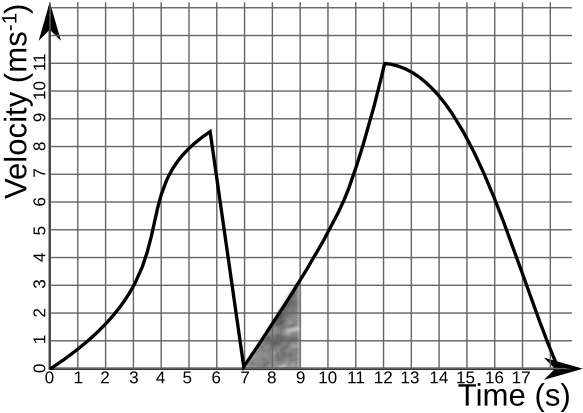User:Inconspicuum/Physics (A Level)/Mechanics 1 Questions
Jump to navigation
Jump to search
Vectors
[edit | edit source]- Which of the following are vectors?
- 20 cm
- 9.81 ms-2 towards the centre of the earth
- 5 km south-east
- 500 ms-1 on a bearing of 285.3°
- A displacement vector a is the resultant vector of two other vectors, 5 m north and 10 m south-east. What does a equal, as a displacement and a bearing?
- If I travel at a velocity of 10 ms-1 on a bearing of 030°, at what velocity am I travelling north and east?
- An alternative method of writing vectors is in a column, as follows:
, where x and y are the vertical and horizontal components of the vector respectively. Express |a| and the angle between a and in terms of x and y.
- A more accurate method of modelling the trajectory of a ball is to include air resistance as a constant force F. How would this be achieved?
Graphs
[edit | edit source]- In the following distance-time graph, what is the velocity 4 seconds after the beginning of the object's journey?
 2a)Describe this person's movements.
2b)What is the velocity at 12 seconds?
2a)Describe this person's movements.
2b)What is the velocity at 12 seconds?
- In the following velocity-time graph, how far does the object travel between 7 and 9 seconds?
- What is the object's acceleration at 8 seconds?
- A car travels at 10ms-1 for 5 minutes in a straight line, and then returns to its original location over the next 4 minutes, travelling at a constant velocity. Draw a distance-time graph showing the distance the car has travelled from its original location.
- Draw the velocity-time graph for the above situation.
- The velocity of a ball is related to the time since it was thrown by the equation . How far has the ball travelled after 2 seconds?
Kinematics
[edit | edit source]- A person accelerates from a speed of 1 ms-1 to 1.7 ms-1 in 25 seconds. How far has he travelled in this time?
- A car accelerates at a rate of 18 kmh-2 to a speed of 60 kmh-1, travelling 1 km in the process. How fast was the car travelling before it travelled this distance?
- A goose in flight is travelling at 4 ms-1. It accelerates at a rate of 1.5 ms-2 for 7 seconds. What is its new speed?
- How far does an aeroplane travel if it accelerates from 400 kmh-1 at a rate of 40 kmh-2 for 1 hour?
Forces and Power
[edit | edit source]- I hit a ball of mass 5g with a cue on a billiards table with a force of 20N. If friction opposes me with a force of 14.2N, what is the resultant acceleration of the ball away from the cue?
- A 10g ball rolls down a 1.2m high slope, and leaves it with a velocity of 4ms-1. How much work is done by friction?
- An electric train is powered on a 30kV power supply, where the current is 100A. The train is travelling at 90 kmh-1. What is the net force exerted on it in a forwards direction?



